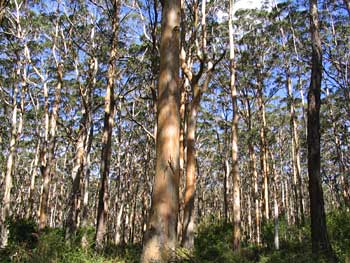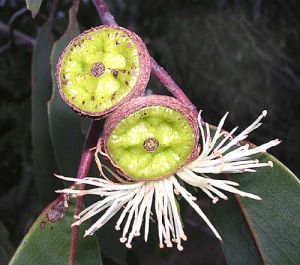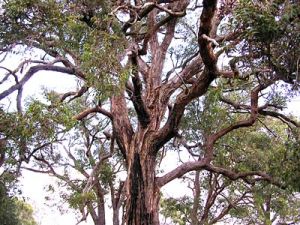|
[Front Page] [Features] [Departments] [Society Home] [Subscribe]

Margaret River, So Much More Than Wine
The eucalypts of the Margaret River forests
Margaret Moir
Fortunately for those of us that value the Australian bush and its biodiversity, the Margaret River region of south Western Australia has more than 60% of its land as National Parks, Conservation reserves, or State Forest. In many areas, there is also a considerable amount of privately owned bush in good to reasonable condition. This contributes to the green, leafy ambiance of the area.
But these trees are much more than just stage props for tourists, they are outstanding eucalyptus of character, beauty and size, which are veritable condominiums for myriads of forest creatures, vertebrate and spineless. The region has an average 1200-1400 mm rain in a strongly Mediterranean climate with cold wet winters and warm dry summers. Most of the rain falls from June-September, with July usually the wettest month, and January the driest. The forested soils are mostly acid ironstone gravelly duplex soils, the terrain undulating, with abundant ephemeral or rarely permanent, creek systems.
Corymbia calophylla [marri, redgum] 3-60 metres
From Latin, corymbium, a "corymb" referring to floral clusters where all flowers branch from the stem at different levels but ultimately terminate at about the same level;
calophylla...from Greek calo, beautiful, and phyllon, a leaf.
This is the tree which perhaps gives the region its unique character more than any other. It is a widespread and adaptable tree, growing tall and majestic on good soils, short and gnarled on poor sand and by the coast. It is widespread as a lone paddock tree, remaining as a remnant of the forests which were cleared for farming. When given space it spreads to become a broad crowned, broad leaved shade tree. [but beware the shedding of branches].
The flowers are huge and beautiful, as are the leaves, very like that of their close relative, the red flowering gum, Corymbia ficifolia. In fact the trees are very similar in leaf, bud, flower and fruit, the major differences are the cream colour of the marri flowers, bark character, [it has grey-brown tessellated bark] and its larger stature. The marri is a stunner in full flower, the blossoms are huge, and born at the tips of the branches, so the tree looks like a virtual cauliflower of bloom. Because of the numbers of marris in the area, lining every road and throughout the bush, in a good flowering season [February - March] the whole region appears to be in bloom, and the strongly honey scented blossoms provide a show as good as any wildflower display anywhere.
| |
 |
| |
Fruits of Corymbia calophylla
Photo: Margaret Moir |
The blooming of the marri provides a bonus for vineyards and orchards, as the birds will feed exclusively on the nectar, and leave the grapes and fruit alone while it lasts. Although the marri blossom is cream or white, which would normally lead us to expect it to be primarily intending to attract invertebrates to perform pollination, it is actually equally sought out by birds and possums. The huge gumnuts are a staple of the diet of lovely and increasingly rare white and red-tailed black cockatoos, while the tree hollows of mature trees are at a premium for the nests of both the cockies and any number of other birds and marsupials.
Phytophthora resistant, but many trees are starting to be infected with a canker which may have serious implications. [two other species of south-west forest eucalypts are suffering severe die back and mass death from as yet unidentified causes, the tuart, E.gomphocephala, and the flooded gum, E.rudis.]
Eucalyptus marginata [ jarrah] 1-30 metres
| |
| Further Information |
| More on WA biodiversity and forests:
More on the marri:
More on jarrah:
More on karri
More on yarri:
|
|
Jarrah is the second major tree species to be a component of our forests. Formerly very common and reaching its best form on well-drained ironstone gravels, it has been much depleted by logging, clearing and phytophthora. Timber cutting has taken place in the area on a colossal scale since the 1860s, much of the wood being exported both to the other states and overseas. The roads of London and Berlin were laid with jarrah before macadamizing. I don't know what to say about that, really.
The timber is a superb hardwood, and is/was used for every building purpose as well as furniture, fence posts [very resistant to white ants] and firewood. Bad luck for the jarrah to be so incredibly useful and profitable. Even nowadays when one hears a chainsaw, it will a jarrah paying the price for its versatility, endurance and good burning properties.
It is very rare indeed to see old growth jarrah, and what there is will be on private property remnants. We can only dream of what it must once have been.
Jarrah is a majestic tall tree, with rough, dark brown to black bark, and fine, narrow leaves. It flowers abundantly in season, [late winter-early summer] attracting numerous insects. It has a remarkable suite of mycorrhizal fungi, and it is possibly some dysfunction of this symbiosis that allow the dieback fungus to wreak such havoc.
When planting a jarrah seedling, I always plant it with some associated acacias, [A.pulchella, A.alata, A.extensa, etc] these seem to enhance the mycorrhizal activity and help give dieback resistance. It is an incredibly slow growing species, taking up to 10 years to make moderate growth. Apparently up to the first decade of its life may be spent developing a massive lignotuber, so that it can survive the frequent fires and other depredations of its habitat.
Eucalyptus diversicolor [karri] 10-90 metres
 |
|
Karri forest
Photo: Margaret Moir |
|
Karri is the third icon species of the region, and is probably familiar as a symbol of anti-logging protests. One of the two tallest hardwood flowering plants in the world [E. regnans is the other], its habitat is only where both rainfall and soils are suitable. Oddly, it is remarkably adaptable when planted elsewhere in the region, and provided winter rainfall is sufficient [at least 1200mm] seems to tolerate any soil type.
It too has suffered much depletion because of the timber industry, but unlike jarrah it is very fast growing and adaptable, so fine stands of regrowth trees abound. It reaches its optimum height in less than one hundred years, and then puts on girth. The Boranup Forest in Margaret River, is a remarkable valley of 100 year old regrowth, now reserved in National Park.
A most attractive and majestic tree, the karri has a stocking of grey bark that peels seasonally to show the smooth pale salmon trunk. Phytophthora resistant.
Eucalyptus megacarpa [bullich] 2-35 metres
| |
 |
| |
Flowers and young fruits of Eucalyptus megacarpa
Photo: Margaret Moir |
Sometimes referred to as bastard karri, this tree has a strong resemblance to karri, although it is much smaller in growth. The greyish bark peels to show the similar fresh and smooth sunset, buff and salmon tones, and in its favoured riparian, valley and swampy habitat it grows straight and upright, but the flowers and fruit are much larger, and quite distinctive. [flowers winter-spring].
It makes a fine ornamental garden tree, and I use it as such here. Fairly slow growing, foliage distinctively blue-grey. Tolerates waterlogging, heavy clay, and is adaptable. Phytophthora resistant. Deserves to be better known and more widely planted, although for garden use, be aware of a great deal of bark drop.
Eucalyptus patens [Swan River blackbutt, yarri]. To 45 metres
 |
|
Yarri
Photo: Margaret Moir |
|
A really superb tree of stature and spreading canopy, a denizen of moist riparian habitat only. Many fine specimens line the Margaret River here at Olive Hill Farm, that would be up to several centuries old. Very imposing girth and spread, what the oldtimers sometimes referred to as an '80 acre gum'. Has the rather unique facility of being actually fire resistant, simply will not burn and takes a very long time to decompose after falling. All useful riparian characteristics, retarding fire on streambanks and making excellent and enduring in-stream habitat.
This species tolerates waterlogging and inundation for quite extended periods. [I have seen them almost submerged for up to 2 months], even infant seedlings can take complete immersion for up to a week and survive.
A very robust pioneer species in its favoured habitat, it will self seed abundantly on cleared riversides when protected from stock. Much used formerly when more abundant for cabinetry and floorboards, but not for firewood! This has really now become quite a rare tree, certainly the bigger ones, and I can only hope it will be spared any more logging under any circumstances.
Flowers abundantly and rather unpredictably, often twice a year. Phytophthora resistant.
From the newsletter of the Eucalyptus Study Group, July 2004.

[Front Page] [Features] [Departments] [Society Home] [Subscribe]
Australian Plants online - September 2004
Association of Societies for Growing Australian Plants
|